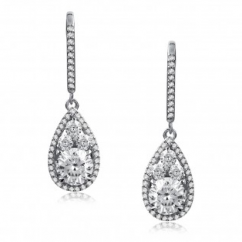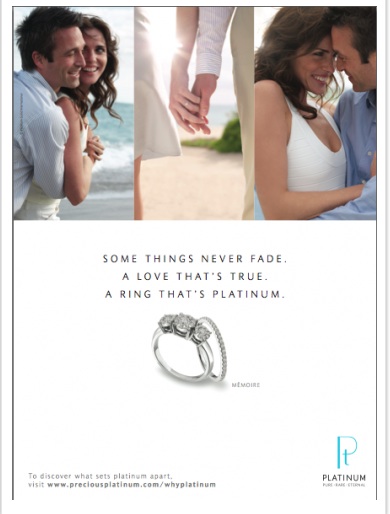Articles and News
INDUSTRY NEWS: DIAMOND PRICES RISE, VERICHANNEL LAUNCHES CONSUMER DIAMOND SEARCH, PGI PROGRAM, MORE January 12, 2012 (0 comments)

PGI to Offer Marketing Support to Manufacturers and Retailers
New York, NY—Platinum Guild International is stepping up its efforts to help both manufacturers and retailers market and sell more of the metal.
At the upcoming Centurion show, PGI will identify exhibitors as “Platinum Destinations,” invite retailers to take advantage of its free store signage program, and inspire them to think about a new business model—dollar profit vs. margin percentage—when selling bridal jewelry.
Last year, PGI changed its trade show strategy. Since its mission is to support the manufacturers and retailers who make and sell platinum jewelry, PGI focuses on those companies’ efforts, not on promoting itself.
The "Platinum Destination" program, which identifies companies that make and sell platinum jewelry--such as the A. Jaffe earrings pictured above left--is part of this new approach. Firms are designated by special tabletop signage in their salons, as well as a "cling" signs for their salon window. These signs also serve as previews of PGI's new free in-store signage program for retailers, being launched at the Centurion Show.
The free in-store signs feature a platinum product image and logo against a background of PGI’s new ad and tagline, "Some things never fade. A love that's true. A ring that's platinum." Retailers can take advantage by visiting any of their Platinum Destination suppliers, then placing an order on platinumsignage.com for signs ranging from Duratrans to tabletop "Kurve" signs, slim-edged light pads, and more. The sign is then made and shipped to the retailer at no cost to them or the featured manufacturer.
PGI’s advertising tagline marks new positioning born of recent consumer research. Many millennial consumers—the core bridal target—were unaware that platinum is naturally white and doesn't change color or fade over time; that is tied to the concept of a lasting relationship. Also, while the metal’s characteristics always make it a good value, says Kevin Reilly, PGI director of business development, the current metal price scenario makes this one of the best times in history to buy platinum. Retailers can seize this opportunity to guide customers in making more informed choices of their engagement and wedding rings, and earn incremental profits at the same time.

PGI's new consumer ads tap into research on the Millennial market showing their desire for lasting value in both jewelry and relationships.
Polished Diamond Prices Rose 17% in 2011
Ramat Gan, Israel—Prices for polished diamonds rose 11% last year, according to the IDEX Online Polished Diamond Price Index, and reported in National Jeweler. In an article written for IDEX Online, industry financial analyst Ken Gassman says the index confirms that polished prices have risen to pre-recession levels after two weak years. Gassman cited a number of factors, both positive and negative, pushing prices up. Positive factors included solid consumer demand in the United States, plus strong demand in emerging markets. Retailers in all segments of the market, as well as diamantaires, re-stocked diamond inventory, even at higher prices that were passed down the pipeline, and overall people finally felt like the recession is over.
Negative factors included liquidity problems in the industry that hurt some diamantaires’ ability to stock and trade, geopolitical volatility around the world, and lack of consistent demand from retailers.
In the near term, things are still somewhat uncertain, writes Gassman. The American economy is poised to pick up steam and is predicted to grow at a faster pace than tepid 2011, but the European debt crisis could be a drag on other nations’ growth. Long term, things look quite bright due to demand in emerging markets.
Verichannel Launches Consumer Search Engine for Jewelry
Dillon, CO--Verichannel LLC, a trade-restricted search engine for the jewelry industry, has launched a consumer version to help retailers and brands break free from what it calls the "Google log-jam."
Marketed under the URL Gemfling.com, the site—in beta mode now—brings together some of the most successful models on the Web, including vendor comparisons in the manner of the travel comparison site Kayak, rewards-based viral techniques popularized by Microsoft's Bing and Groupon, and back-end technology powered by Google itself.
"After our first year successfully helping retail stores connect more efficiently with suppliers, we are now extending our patent-pending technology to help consumers more easily connect with retail stores and brands," said Verichannel CEO Jacques Voorhees. "Based on our research, there is almost a marketing crisis occurring at this level. Consumers increasingly go to the Web as a starting point, and that means Google or one of the other search engines. But if you're not on the first page in the results, you're invisible. And everyone in the industry is trying to be on that first page, which of course is impossible. It's a logjam that is just as frustrating to consumers as it is to suppliers.
"You don't go to Google to buy an airline ticket, you go to Expedia," Voorhees said, explaining that it’s a specialized search engine focusing on the unique characteristics of the travel industry, and delivers a more efficient shopping experience for the consumer. Gemfling will, provide similar efficiency for jewelry shoppers.
Gemfling's functionality is divided into three components: a key-word search system based on back-end Google technology, but restricted 100% to jewelry industry websites; a Kayak-style shopping architecture that divides the Web into specific channels (local stores, e-tailers, brands, and b2c multi-vendor platforms like eBay and Yahoo-shopping); and a store locator tied into Google Maps.
"The shopping architecture is the core of the system," explained Voorhees. "It uses proprietary technology to serve up powerful jewelry-specific filters -- such as American Gem Society membership -- and delivers results in side-by-side spawned browsers, similar to Kayak.
The site launched January 11. A rewards-based viral marketing program will begin in second quarter 2012, which rewards both retail stores and consumers based on usage and promotional (viral) activity. The site expects to serve up every consumer-facing company in the jewelry industry.
"We recommend all retail stores visit www.gemfling.com/shopping/localstores and search their postal code to ensure their information appears properly," adds Teri Welsch, Verichannel’s customer service manager. "Every company in the industry can go to the site, register at no cost in the Trade section, and add or make changes to their own data."
Placement within Gemfling, for both retail stores and brands, is being offered on a first come, first serve basis. For more information contact Verichannel at (917) 512-2393, or email teri@verichannel.com.
JVC, JSA Present Annual Awards
New York, NY—The Jewelers’ Vigilance Committee recently honored Aron Suna with the Stanley Schechter Award at its annual luncheon, held Friday, January 6, at the Waldorf Astoria Hotel. The award was named for the late founder and chairman of Honora Industries, who was a staunch supporter of the JVC. Cecilia Gardner, JVC CEO, praised Suna’s commitment to the organization and his tireless efforts to promote integrity, as she handed him his award.
The keynote speaker for the lunch was Mark Green, host and moderator of Both Sides Now, a syndicated talk show. He also is an attorney, author, and New York City’s first public advocate. He discussed the jewelry industry’s role in the city and vice versa.
The Jewelers’ Security Alliance on Saturday honored Paul Jones, senior director of global asset protection for eBay/PayPal with its annual Industry Service Award, for his firm's partnership with the jewelry industry to fight jewelry fraud and crime online. JSA also presented its annual James B. White Law Enforcement Award to supervisory special agent Eric B. Ives of the FBI’s Organized Crime Section, Jewelry and Gem Program, Washington, D.C.
“Both jewelry and art crime are gateway crimes,” Ives told the audience. It’s never just about the jewelry or the art, he said—it’s about what the profits from fencing both might fund, such as global terrorism, which is why jewelry and art crimes are so important to the FBI.







